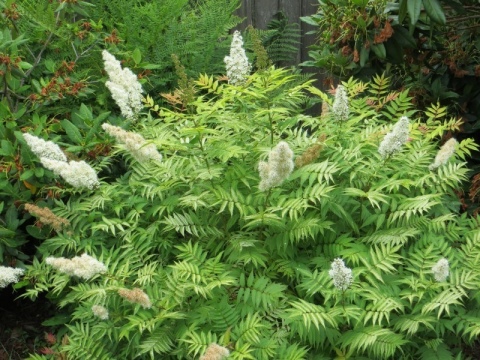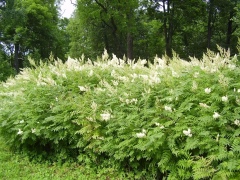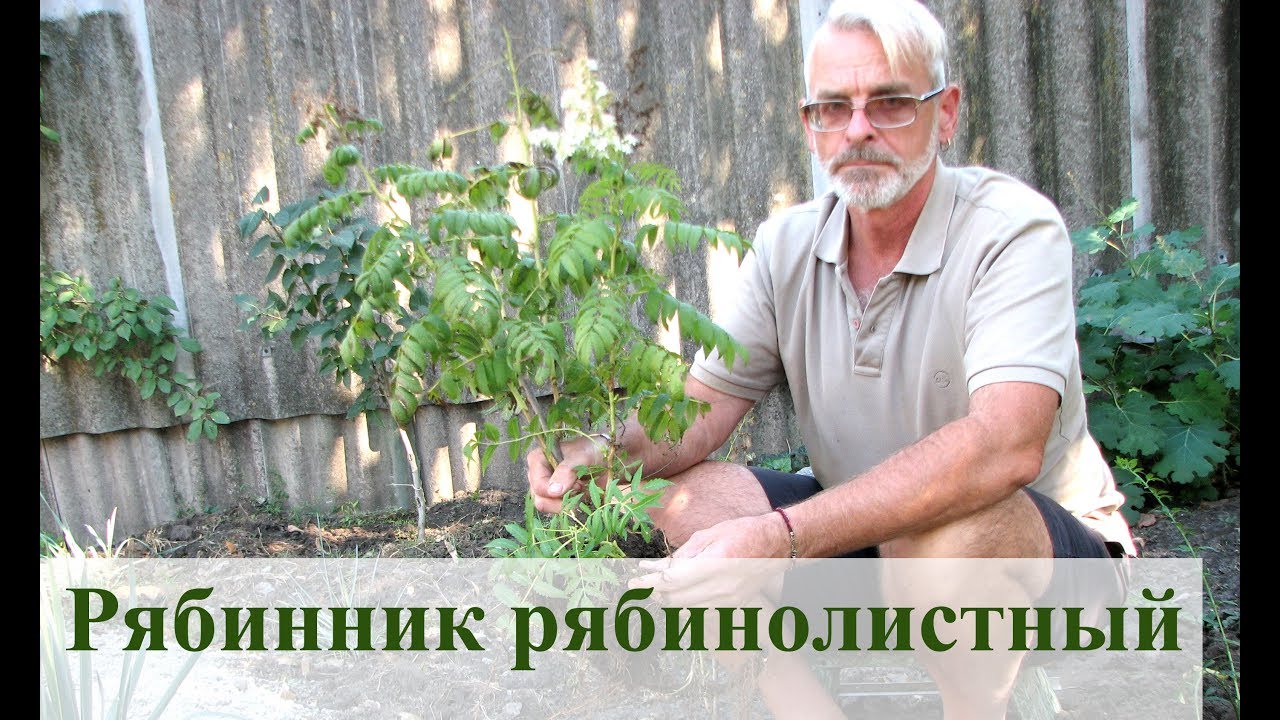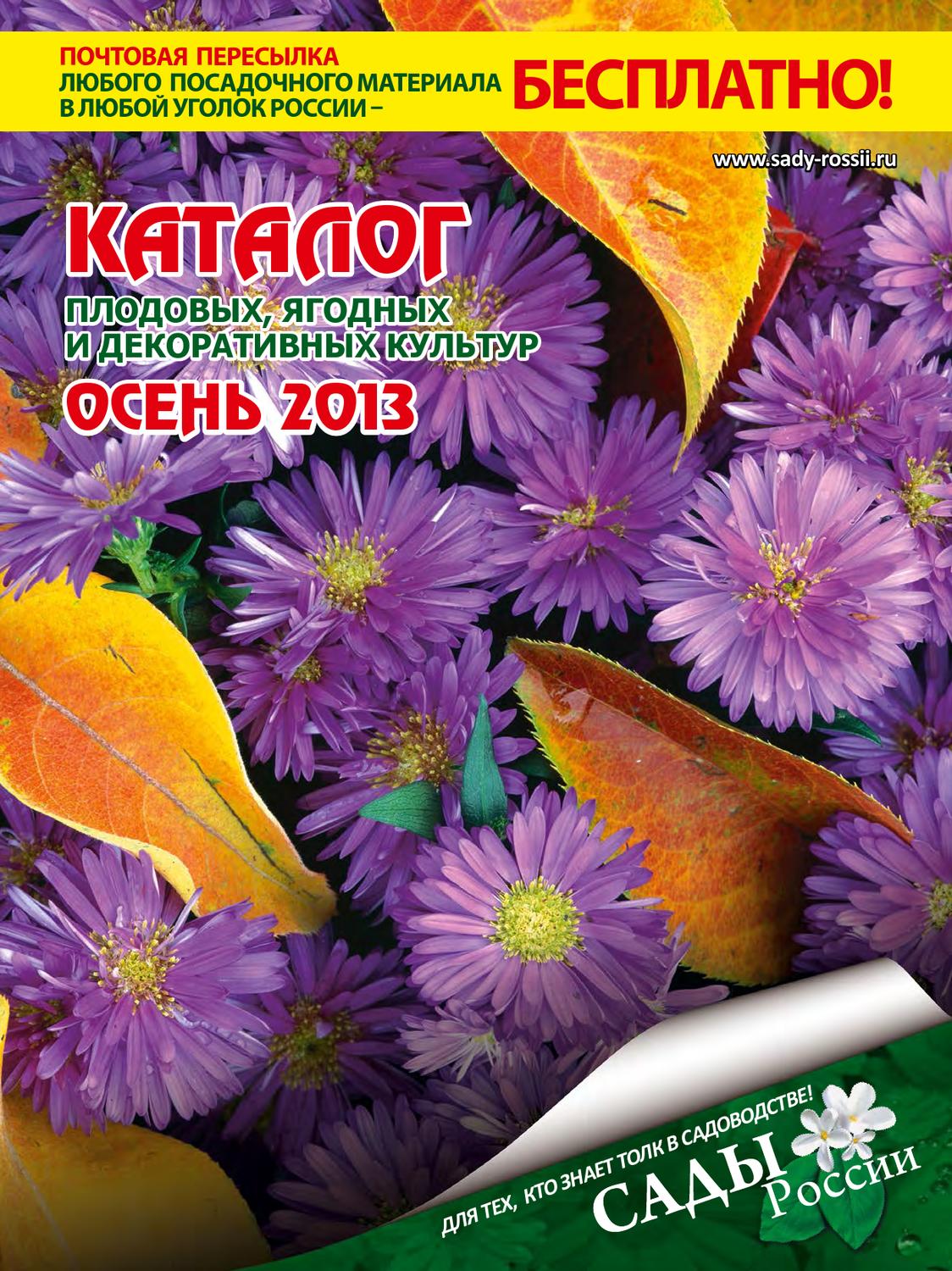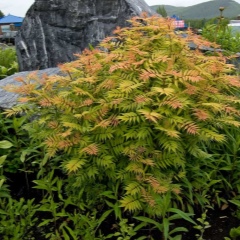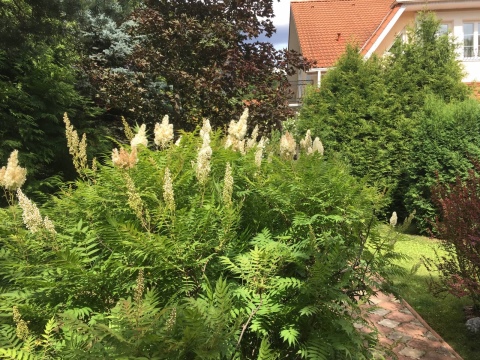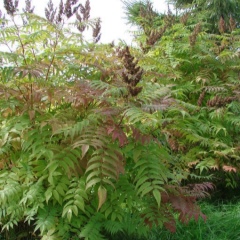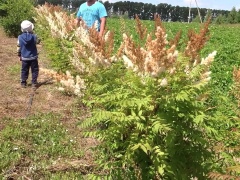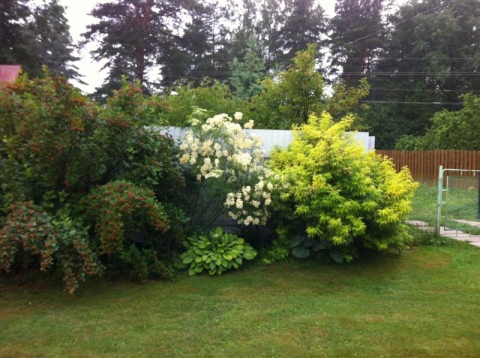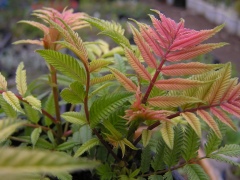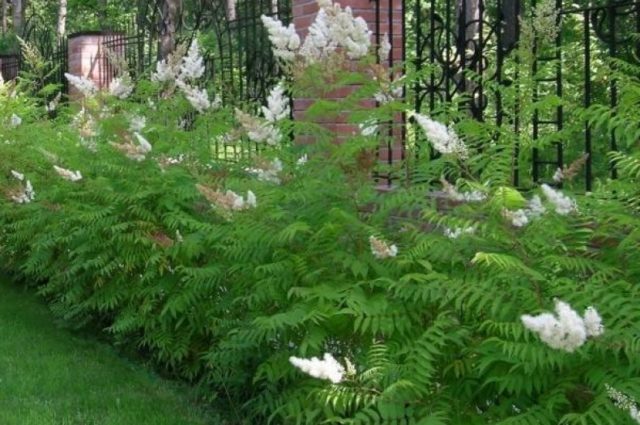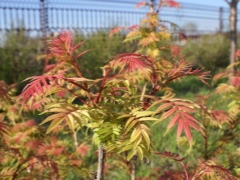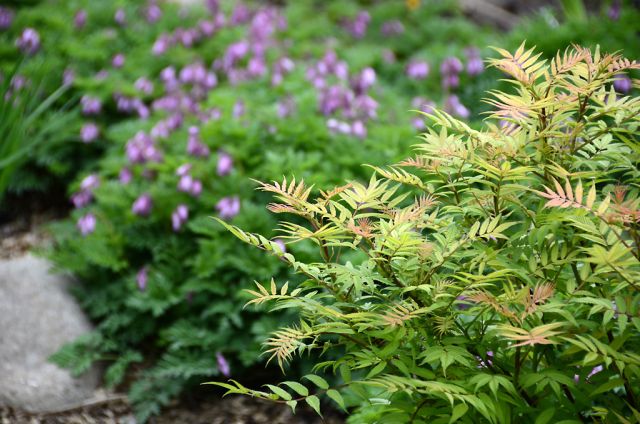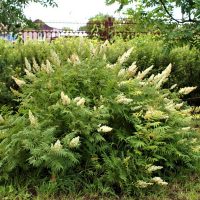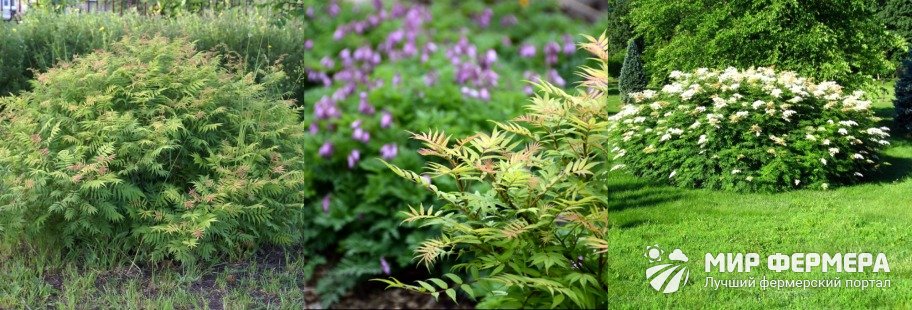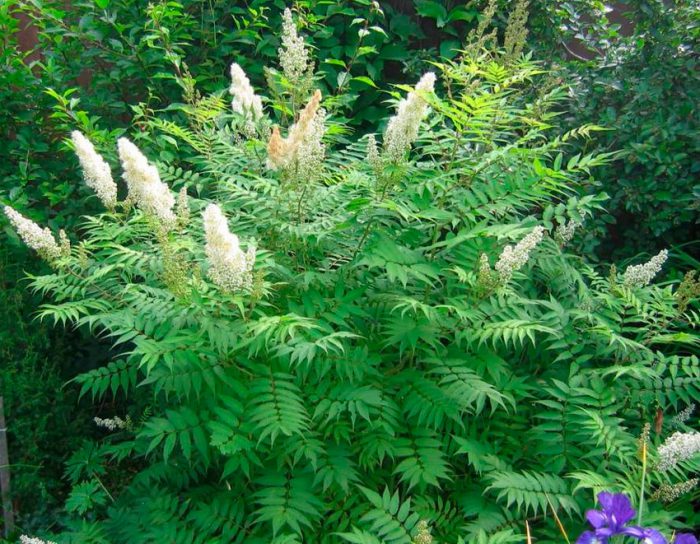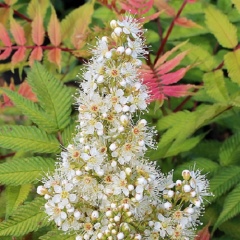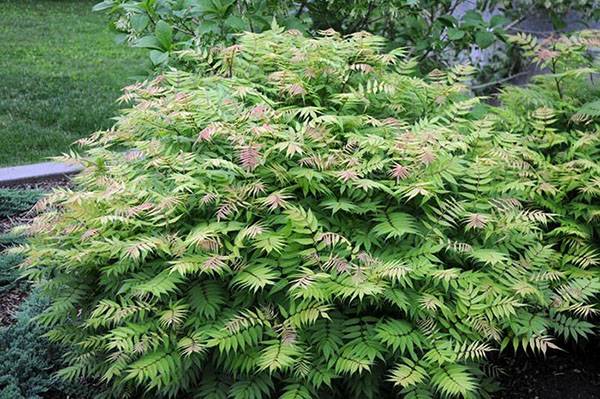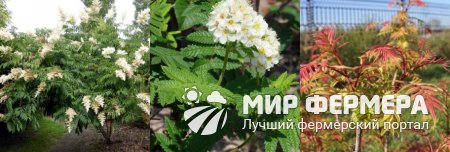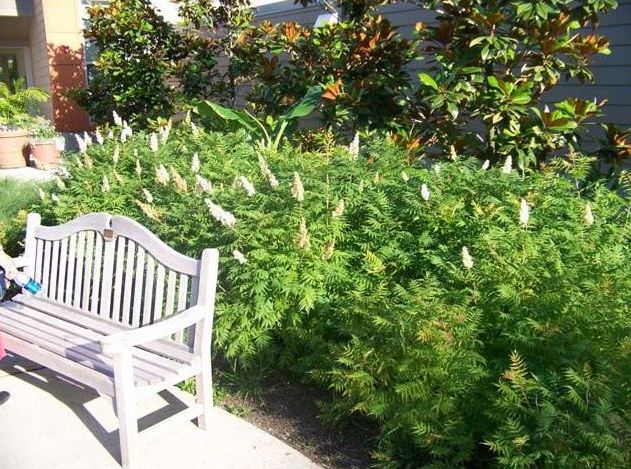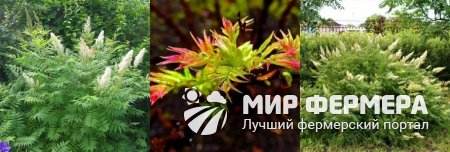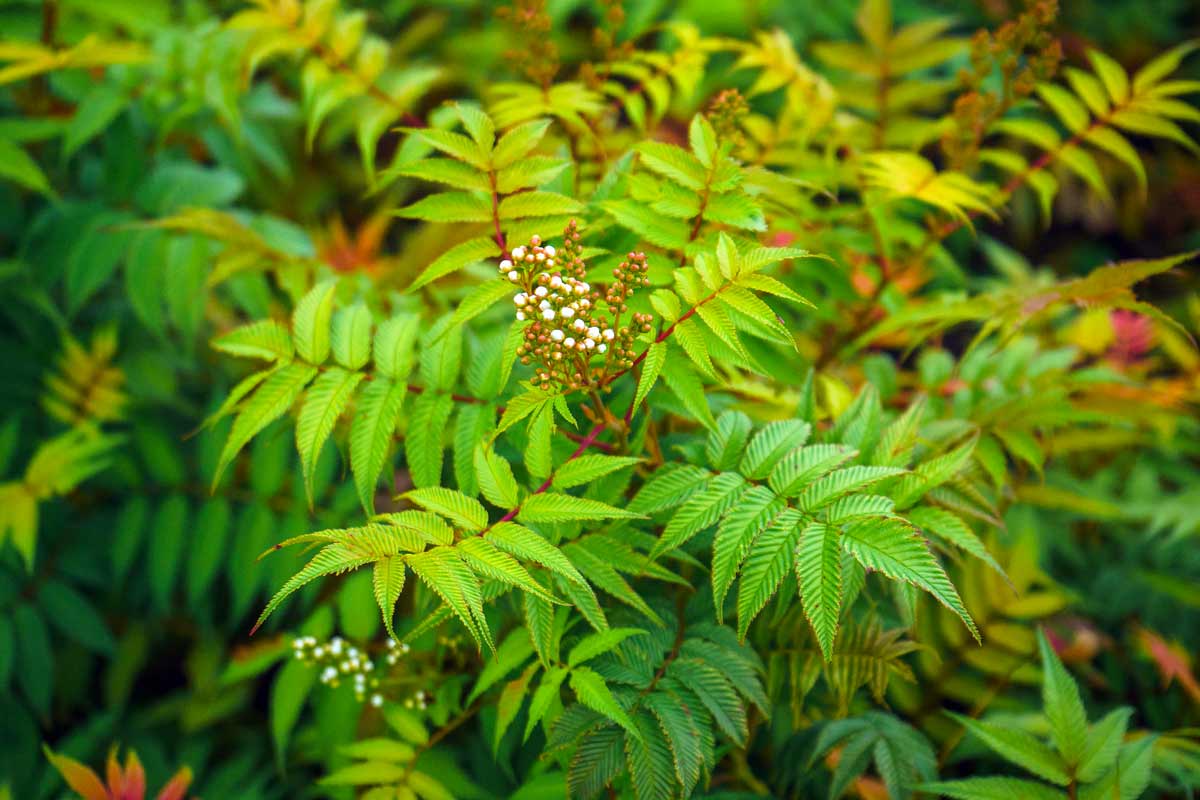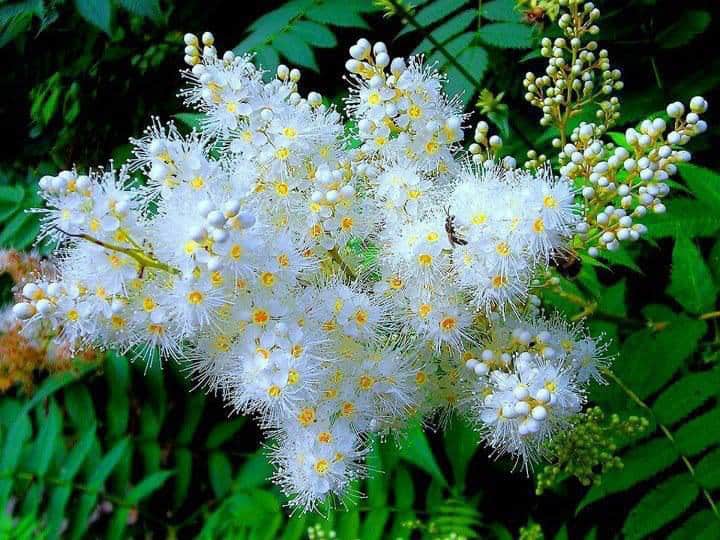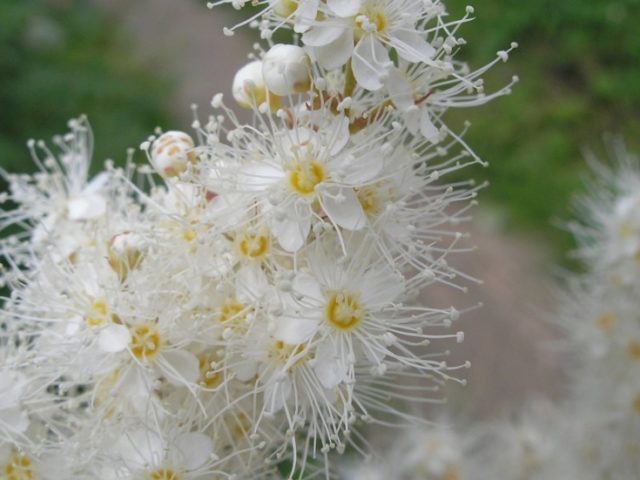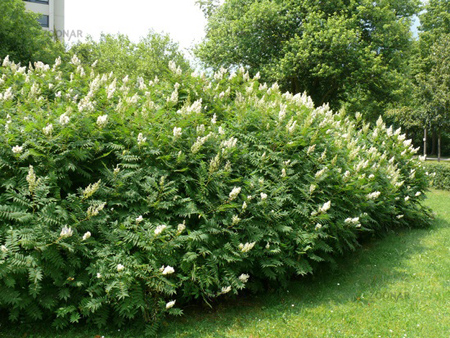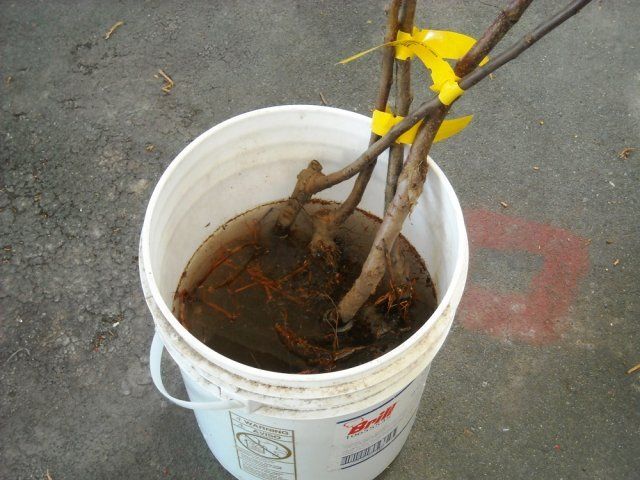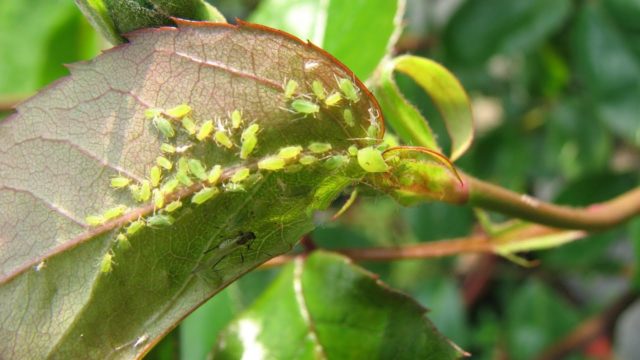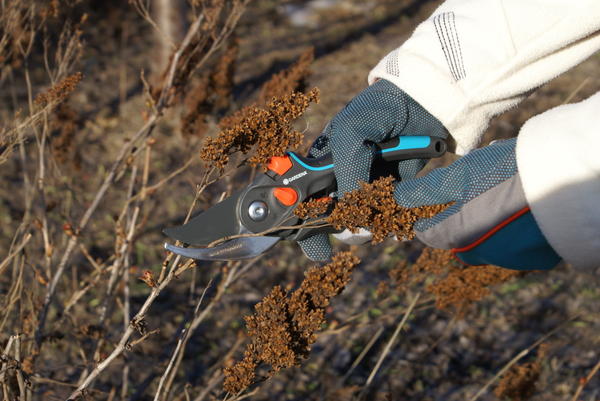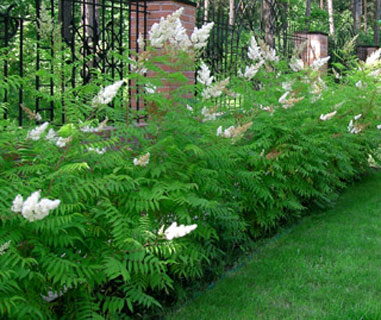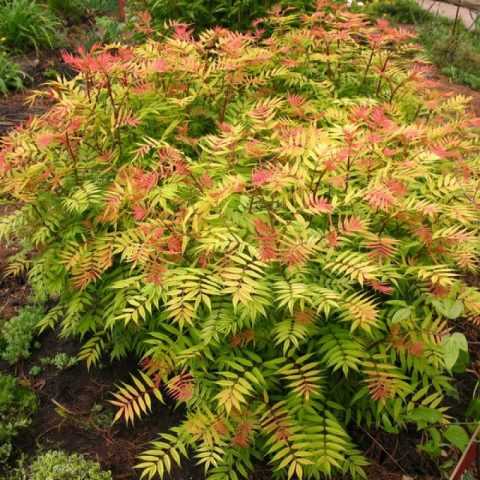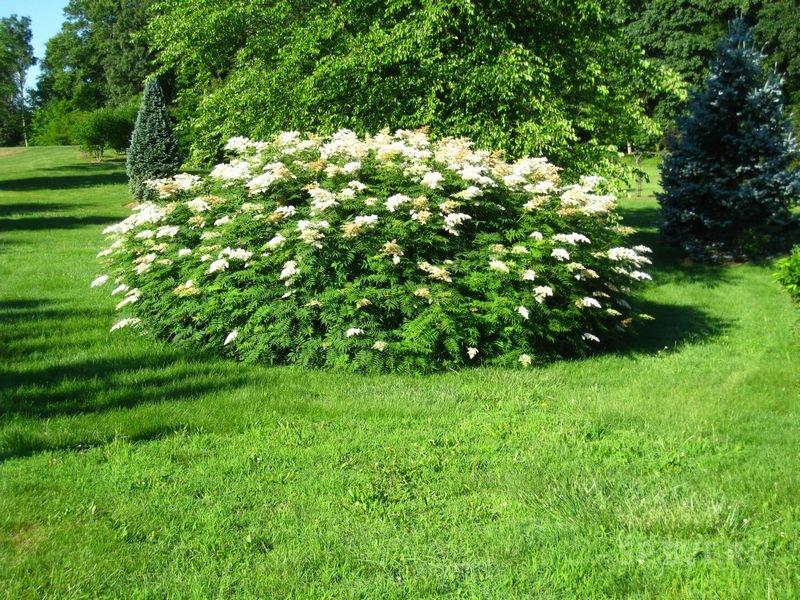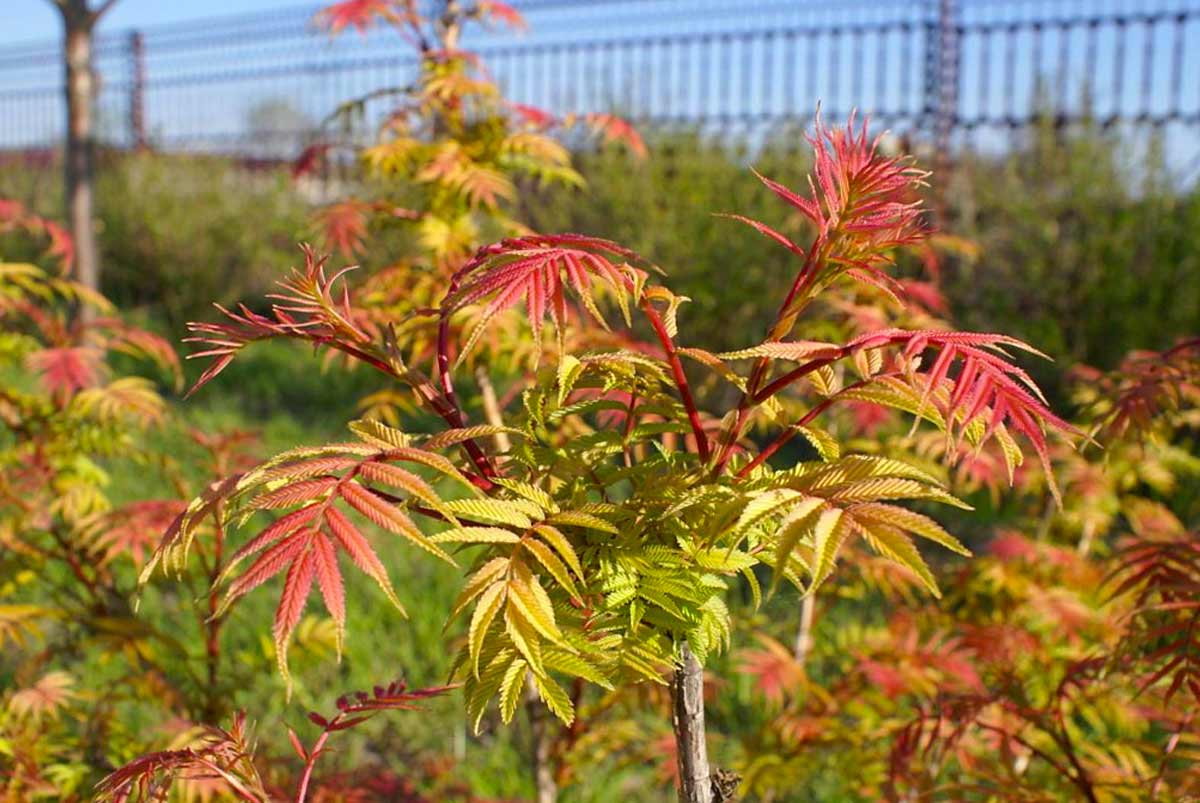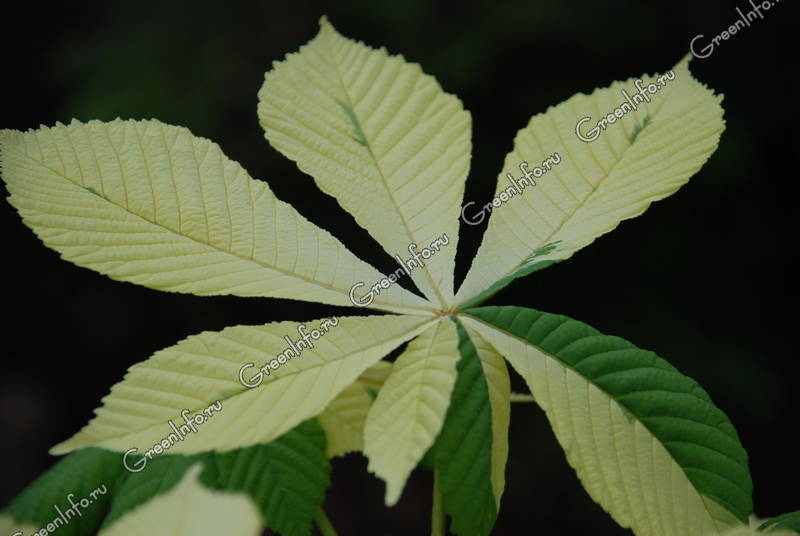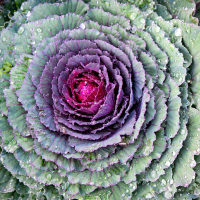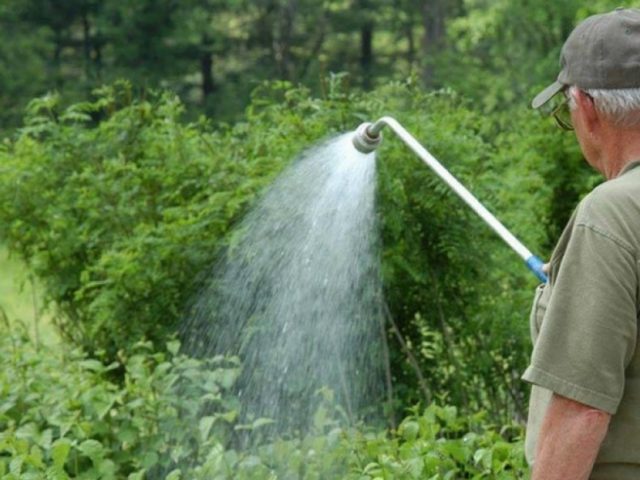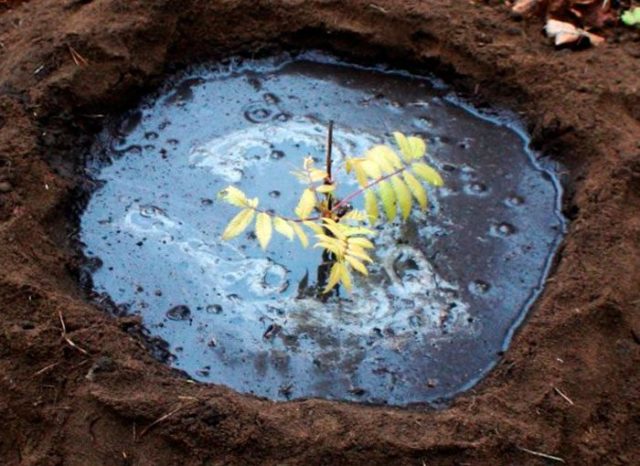How to plant a plant correctly
Planting mountain ash in the open field does not present any particular difficulties. But in order to the plant grew actively and looked decoratively, some details should be taken into account:
- The fieldfare, even if it is provided with minimal care, feels good both in the sun and in shade. The ideal location for the landing is the eastern side of the site.
- All varieties of fieldfare love moist soil. However, everything should be in moderation. Growing a plant in swampy areas is fraught with disease, and even death. In any case, a drainage device is required.
Advice. In the soil, in the place where the planting will be carried out, it is advisable to apply organic fertilizer in advance. This will accelerate the growth of fieldfare.
Directly planting a bush is as follows:
In early spring, when the leaves have not yet blossomed, or in late autumn, when they have already fallen, they dig a hole in the open ground with a depth of 40 cm and width not less 80 cm.
The bottom is covered with any suitable drainage material.
A little soil is poured on top, into which a nitrogen-containing fertilizer is mixed.
Place the seedling in the hole so that the root system is not hampered by anything.
Carefully cover the roots with earth. Lightly rammed.
Planting fieldfare
A hole is formed around the trunk.
Good watering is required after planting.
Attention! It should be borne in mind that mountain ash has the ability to grow uncontrollably. Therefore, immediately after planting, it is advisable to install root restraints.
Growing mountain ash in the garden is not particularly troublesome. Basic care consists of the following stages:
- Watering should be distributed so that the soil around the plant is always moist.
- It is also necessary to constantly keep the soil loose. This will allow air to flow freely to the roots.
- Grooming includes pruning. They spend it in the spring. The procedure allows you to control the height and width of the shrub. In addition, the plant takes on a well-groomed appearance. For example, if field planting is used as a hedge, then it is enough to leave shoots 1 m high. Flowers grow on a new growth, so pruning does not affect their quality and quantity.
Advice. Cut off sections of shoots can be used for propagation of shrubs by cuttings.
The rowan-leaved variety does not require any warming before wintering in the open field. It is quite hardy and does not get damaged even in very cold winters.
Rowan-leaved fieldberry
sorbaria sorbifolia
Young leaves on it can be seen in early spring, the bush is one of the first to wake up. Blooming shoots turn pink at this time. Later, the plant is covered with light green leaves, and in autumn the color changes to red and yellow. The mountain ash-leaved field is decorative all season.
 Fieldfare leaves in early May. Photo
Fieldfare leaves in early May. Photo
At the time of flowering, and this happens in July, the bush is covered with numerous fluffy and long (up to 30 cm) panicles of white flowers. It is an excellent honey plant and attracts a large number of pollinators, including beetles.
Flowering lasts about a month. Dried inflorescences do not look very aesthetically pleasing and require removal. However, this procedure can also be carried out in early spring during sanitary pruning.
Two varieties are popular in Russia:
- "Stellifila" - is distinguished by its special winter hardiness and original brownish leaf pubescence;
- "Sem" is more often chosen for hedges, as it produces growth less aggressively.
different sources of the middle lane
 Pruning of fieldfare inflorescences in April. Photo
Pruning of fieldfare inflorescences in April. Photo
In nature, mountain ash grows along the banks of water bodies, so it normally withstands short-term flooding, but is less resistant to drought. Therefore, in a particularly hot period, it requires watering.
From the fieldfare of mountain ash, it turns out excellent. He can replace, or. The fieldfare grows quickly and tolerates a haircut well, so many choose it precisely as a plant for a green fence or backstage.

This shrub is well suited to the neighborhood with. On the one hand, it will not suffer from a lack of moisture, and on the other hand, it will help strengthen the soil on the shore, since the root system is dense. For the same purpose, it is planted on the slopes.
Growing up, this shrub covers garden corners well, even shady ones. In group plantings, fieldfare looks interesting together with various species, especially yellow-leaved ones. White panicles of flowers set off favorably. In general, fieldfare looks very natural, "natural", so it is suitable for any informal style.
Find on your site a place for this wonderful shrub, modest in its unpretentiousness, but can become an excellent member of the garden "family" of ornamental plants.
Decorativeness to this shrub is not given by flowers or fruits, but by delicate complex leaves that change color depending on the season. How to properly plant and care for a plant outdoors? What are the varieties of field bush besides mountain ash? The answers to these questions can be found in the article.
Features of mountain ash in the landscape design of the garden
The interest of landscape designers in the use of mountain ash in the design of gardens, parks and green areas is understandable. The openwork foliage of this plant changes color following the change of seasons, which allows it to remain a real decoration of the site in throughout the year... So, in the spring, young shoots of fieldfare have a delicate, pink-lilac color. With the onset of summer, they acquire a juicy bright green hue, while in the fall the leaves of mountain ash spirea are painted in red and yellow tones.
In addition to the extremely beautiful crown, the mountain ash is also distinguished by its lush flowering. In early June, the plant is covered with large paniculate inflorescences up to 25 cm in length, consisting of many white fragrant flowers. The flowering period lasts until the end of August, after which the flower petals fall off, but the inflorescences themselves remain on the shrub. They should be pruned periodically to make the plant look neat and well-groomed.

Important!
Young fieldfare seedlings begin to bloom 2 to 3 years after planting.
Other features of the mountain ash is its rapid growth rate. With proper care, the plant grows strongly in breadth, therefore, when planting, it is necessary to maintain a distance of at least 80 cm between the plants. The shrub should be pruned regularly to form a more compact silhouette. This can be done up to 3 times a year without fear of damaging the plant, since it is successfully recovering after cutting.
In addition, under favorable conditions, the culture produces abundant root growth. So that the mountain ash plant does not capture the nearby territories, it will not be superfluous to install a protective ring around the plant rhizomes.
Advice!
Rowan-leaved spirea is the best choice of a plant for growing in beekeeping farms, since its flowers are considered excellent melliferous plants.
Care
The unpretentious fieldfare does not require increased attention to itself, including before winter, since it hibernates perfectly without shelter at any age. However, regular, simple maintenance will help the plant to fully reveal its decorative qualities.
Watering and feeding
The fieldfare does not like drought, but it tolerates excess moisture well. A rare case for garden plants - you can not be greedy when watering.First-year bushes are often and abundantly watered - every 6-7 days, and in the absence of precipitation - 2 times a week. Adult plants are watered every 10-15 days, excluding dry periodswhen watering is required weekly. It is also useful to spray the bush with water abundantly in the heat - they do this in the evening, at sunset.
Top dressing consists of organic matter: peat, humus or compost. They are added twice per season: at the beginning of the growing season and during flowering.
Fieldfare does not mind minerals. They are brought in according to the schedule:
- spring - urea, 40 g / sq. m;
- flowering period - potassium nitrate, 15 g / sq. m;
- early autumn - superphosphate, 40 g / sq. m.
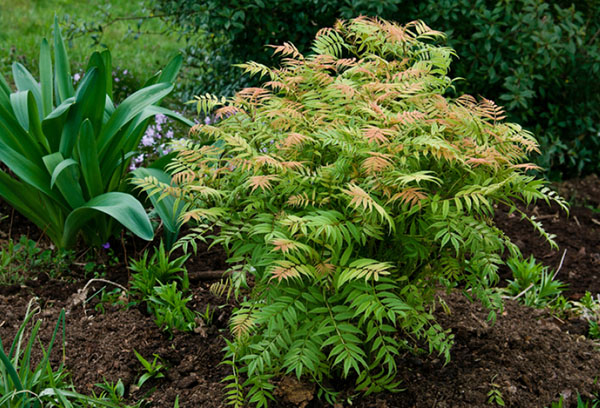
Soil treatment
Loosening is carried out very carefully, processing only the top layer of the soil. The procedure is carried out monthly, after watering
Then the trunk circle is mulched again.
Weeds are removed as they emerge. While they are young, it is easier to pull them out of the ground, at the same time the soil will become looser.
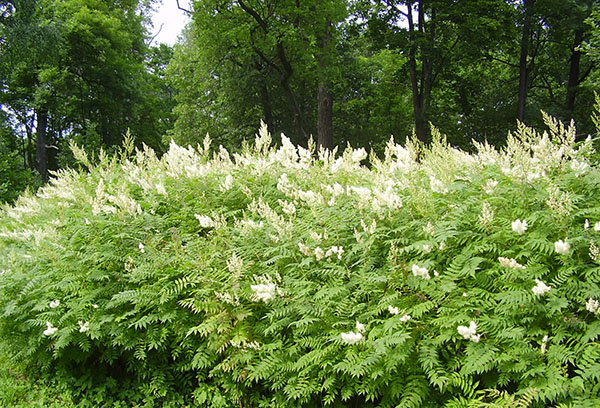
Pruning
Sanitary pruning is done regularly since spring. Removes broken or frozen shoots over the winter. Branches bent close to the ground are also removed if there is no need to grow layers for reproduction.
The shrub begins to form in the third year. To give the fieldberry a neat, well-groomed look, the shoots that break out of the outline are shortened or cut out. The process begins in the spring, during the growing season, branches are regularly trimmed, including those with faded inflorescences, to maintain the shape of the bush.
The mountain ash hedge is trimmed several times per season. In this case, shoots are usually cut off to one meter.
Thinning of the crown is carried out as needed. Excessively dense thickets force the shrub to throw out thin branches, devoid of decorativeness and aging very quickly.
Rejuvenating pruning helps maintain the beauty and health of fieldfare. The signal for rejuvenation is the drying of the upper parts of the branches and their exposure from below. Such branches are cut out completely. Once every few years, a procedure for complete rejuvenation of the bush is possible, when all the shoots are cut "on a stump".
When pruning, they pay attention to the root shoots - all excess is removed, cutting to the very root, otherwise the bushes will lose their shape
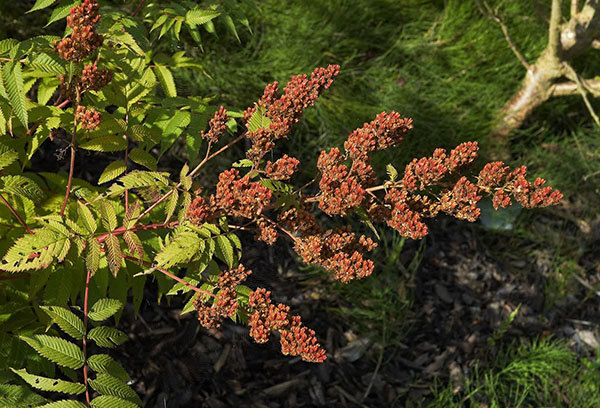
Description
In the wild, the plant is found in Japan, Siberia, Korea and China. Basically, the culture grows on the coastal slopes of rivers and forest edges, forming vast thickets and thickets. Under natural conditions, the bushes grow up to two meters and are distinguished by gray-brown foliage. Outwardly, the appearance strongly resembles mountain ash, but the tips of its leaves are more pointed.
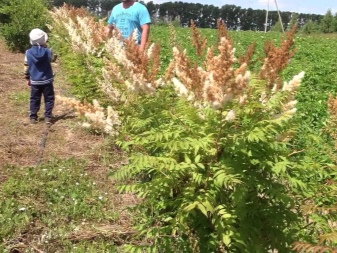

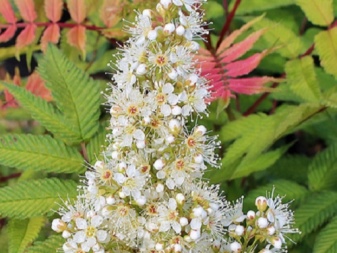

Consider the features of the appearance of the field ash "Sam".
The crown of the bush is lush, spreading, but neat. Its circumference is about 4 m, and its height is 2-3 m.
The branches are straight, the leaves 25 cm long have 12 pointed leaves of a light green color when blooming. Closer to autumn, they turn yellow and red. The pinnate foliage is the same valuable decorative adornment of the variety as the fieldberry flowers.
The long pyramidal inflorescences are composed of small fluffy white flowers, emitting a pleasant aroma, their length is 25 cm. The flower scent is so fragrant that it is able to collect many insects around the plant.
Deciduous shrub has a highly branched root system that forms many root children
It is located in the surface layer of the soil, therefore, when planting, it is important to take this circumstance into account, and not to plant other plants nearby.
Fieldfare is covered with foliage earlier than other crops and looks elegant, preserving the beauty of the crown from spring to late autumn. The plant looks especially luxurious during flowering, although it is very short - from 15 to 30 days.
A beautiful view of the shrub is maintained by constantly growing young shoots
The variety begins to bloom when it reaches 2-3 years of age.
The fieldberry fruits are intergrown leaflets - simple polysperms in a dense leathery shell, they are devoid of decorativeness, therefore, after the end of flowering, it is better to remove the inflorescences.
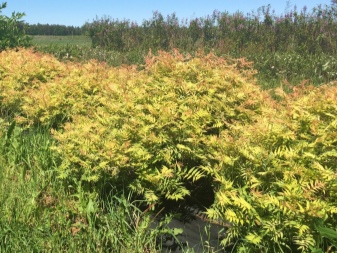

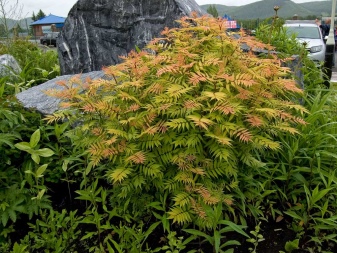

The plant is not too demanding on the quality of the soil, it is highly winter-hardy (it can withstand frosts down to -40 degrees), but it needs constant moisture. The field ash "Sam" is a culture with pronounced phytoncidal properties that not only tolerates gas pollution well, but also cleans the air space around itself from harmful impurities. The species develops and grows rapidly, in one place the bush can live up to 20-30 years, but, of course, with normal care.
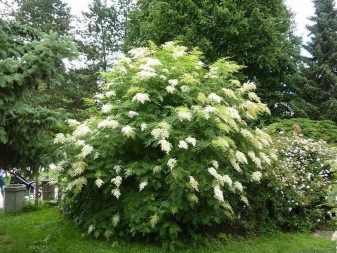
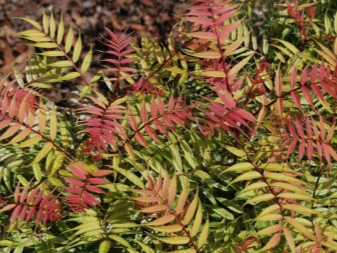
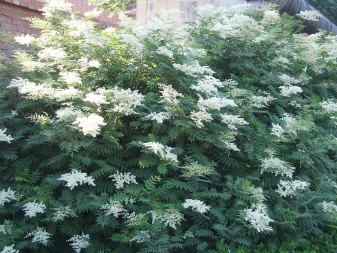
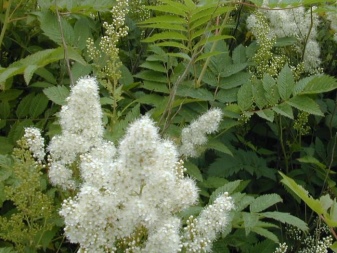
Origin and appearance
Fieldfare bush (Latin Sorbaria) belongs to the Pink family. The plant is found in many Asian countries.
The genus is represented by only 10 varieties of culture. The name that the bush has comes from "sorbus", which means "mountain ash" in Latin. A similar name is associated with the fact that the leaf plates of this culture are almost identical to rowan ones. The only difference is that the rowan leaf is usually slightly larger.

Amazingly beautiful fieldfare flowers can be the best decoration of the infield
As an ornamental plant, fieldfare has been planted for a long time - from about the 18th century.
The plant is characterized by sinuous gray-yellow stems. The bush itself can grow up to 3 meters. Flowers of an ornamental shrub form panicle-shaped inflorescences in the form of a pyramid, consisting of a large number of small flowers. The latter can be white or cream in color.
How to care for an ornamental shrub
As noted above, the fieldfare is not capricious and does not require careful care, but it will thank you for a little bit of attention, revealing its beauty in full.
How to water a plant
The fieldfare does not tolerate prolonged drought, but it is very moisture resistant, easily withstands slight flooding. Therefore, when watering, it is better to overdo it than to be careful and regret water for the bush. Immediately after planting and the first year, watering is often and abundantly.
With further care, root watering is sufficient 2-3 times a month (in hot dry weather, it is worth more frequent). If the plant is not exposed to direct sunlight (or after sunset, if the plant is in the sun), you can douse the leaves with water - it loves high humidity.
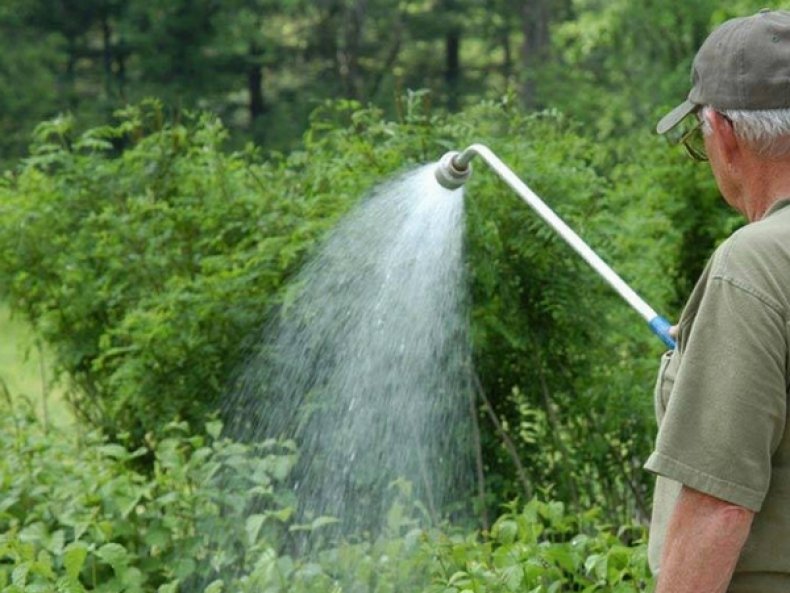
Weeding and loosening
Deep weeding of field ash is contraindicated, since it has a developed non-deepened root system. The first year of life, you can help him fight weeds, then he will cope on his own. To avoid drying out the soil, it is worth mulching it with peat or bark several times a month after loosening the trunk circle.
Top dressing and fertilization
Since the shrub has a developed green mass, moreover, it is renewed during the season, it requires regular feeding. You can limit yourself to organic fertilizers: peat, humus, compost; you can add mineral fertilizers: urea (in spring, about 40 g / m2); potassium nitrate (about 15 g / m2); superphosphate (in early autumn, about 40 g / m2).
Important! The fieldfare does not tolerate deep weeding, therefore fertilizers (both organic and mineral) are applied either directly to the trunk circle, or shallowly embedded when loosening the soil.
Shrub pruning
In the third year, it's time to prune. First of all, cut dry, broken, diseased and creeping branches on the ground. To shape, remove those branches that go beyond the projection of the shrub. Shaping haircuts are carried out throughout the season.
When using a shrub as a hedge, it will have to be cut 3-4 times per season.
In addition, you will need to pay attention to the root growth, which tends to grow, and the hedge may lose its shape.
Landing in open ground
It is not difficult to plant a shrub with leaves like rowan in open ground.
What is needed for landing
All that is required for planting a crop outdoors is a basic knowledge of the plant and its needs and the desire to grow a beautiful shrub.

Even a child can handle planting fieldfare
Another point that you need to pay attention to is the right timing for planting a bush. As a rule, it is necessary to land in early spring to early sap flow or in the fall at the end of foliage
Where to plant
Since fieldfare is a highly shade-loving plant, it should not be placed in open sunlight. The shrub will feel much more comfortable in the shade. That is why the culture is often planted under high villages.
As far as soil is concerned, any type of fertile will do. The plant will feel equally comfortable both in damp and loose soil, and in dense clay.
Planting step by step
Planting a bush in open ground involves a number of steps:
- Dig a hole in the open ground with a depth of about 40 cm.
- The bottom of the pit is covered with drainage material.
- A small amount of planting soil is poured onto the drainage.
- Nitrogen-containing fertilizing is added to the ground in the amount recommended by the manufacturer.
- A seedling is placed in the pit.
- Gently sprinkle the plant with earth and tamp it lightly.
- A neat hole is made near the trunk to prevent moisture from spreading during watering.
- Water the seedling.
Use in landscape design
To complement or decorate landscape design, fieldfare is most often planted alone or together with other garden plants. A large mountain ash bush looks majestic and impressive against the background of all other flowers. It looks especially beautiful during the flowering period - then its snow-white lush buds are able to attract hundreds of insects. Often, fieldfare is also used to form a hedge in the country. In order to highlight a landscape object on a site, it is usually the undersized varieties of this plant that are used. If we talk about compatibility, the fieldberry looks best together with hosts, badans and geykher. However, it can also create a charming contrast in conifer-dominated landscaping.

For information on how to properly care for the field ash, see the next video.
Field care in the garden
Caring for fieldfare is quite simple, and even a beginner can handle it. Remember that the soil near the bushes should always be slightly damp and loose. Provide him with timely removal of root growth and weeds, and feed regularly (when grown in poor soil). Formative pruning is done only when necessary.
Watering should be plentiful, especially if there is a prolonged drought. Top dressing is carried out in small portions at least 2 times during the season, while the nutrient mixtures are shallowly embedded or applied superficially. The shrubs are fed with compost, peat or humus, in some cases, complex mineral fertilizers are also used.
In order for the appearance of the plant to always remain as effective as possible, it is necessary to promptly cut off the inflorescences that have begun to fade. At the very beginning of the spring period, sanitary pruning is carried out, for this you need to cut out all injured, damaged by pests or disease, dried branches, as well as those that thicken the bush. If you do not thin the bush, the stems will become thinner, weaker, and they will age very quickly. Fieldfare tolerates pruning well, even rejuvenating. Remember to cut out root shoots systematically.
Transfer
The shrub tolerates transplantation very well. This procedure is very often performed together with the division of the bush. The preparation of a new planting pit should be done in autumn or spring.A drainage layer should be placed at its bottom, and a soil mixture should be prepared, consisting of soil removed from the pit, as well as compost or humus. Remove the bush from the ground, and, if necessary, cut it into several parts, while taking into account that each delenka must have powerful shoots and well-developed roots. Places of cuts should be sprinkled with crushed charcoal, then the cuttings are planted in new places. If you do not divide the bush, then the dug out plant will need to be placed in a planting hole, which is filled with prepared soil mixture. The soil around the shrub is compacted, and then abundant watering is carried out.
Fieldfare propagation
Such a plant can be propagated by dividing the bush, this procedure is described in great detail above. Theoretically, fieldfare can be propagated by seeds, but in practice, seedlings appear very rarely. Most often, gardeners propagate this shrub with lignified cuttings and layering.
It is very simple and easy to propagate fieldberry by layering. In springtime, it will be necessary to choose a strong, healthy and long stem, and bend it to the surface of the site so that several buds are in contact with it. Then the stem is fixed in this position and covered with soil, while its top should remain free. Do not forget to water the cuttings in a timely manner in the summer. After a few weeks, the cuttings will take root, and in late summer or early autumn it can be cut off from the parent plant and planted in a new place.
Cuttings are cut from lignified stems, while the length of the apical segments can vary from 20 to 30 centimeters. For rooting, they are planted in a box filled with earth mixture. Keep the soil slightly damp at all times. If the cuttings root successfully, their tops should begin to grow.
Diseases and pests
Such a shrub is distinguished by high phytoncidal properties, which explains its resistance to diseases and pests. Very rarely, green aphids or spider mites can settle on it. Such sucking insects suck out the plant sap from the bush, as a result, it becomes lethargic, and the stems are deformed and the foliage turns yellow. In addition, there is a high probability that such pests will infect the fieldfare with a viral mosaic. This disease cannot be cured, and therefore all you have to do is dig up and destroy the plant. To get rid of such insects, they resort to treating the affected specimen with Fitoverm or Mitaka solution.
Varieties
Despite the fact that today only 5 varieties of such a plant as field ash are officially fixed, gardeners are actively growing 7 separate species.
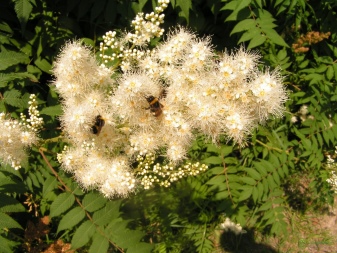
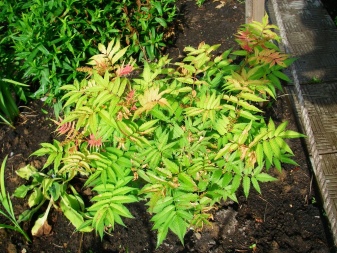
Common mountain ash
This is the most common variety of fieldfare, which in its natural environment can be found near large bodies of water. In height, such shrubs usually do not exceed 2 meters and have erect gray shoots. A distinctive feature of such plants is the characteristic orange color of the leaves in the spring.
At the beginning of cold seasons, the color of the leaves becomes bright red at all, which cannot but attract the attention of passers-by.
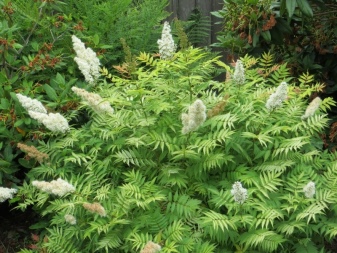
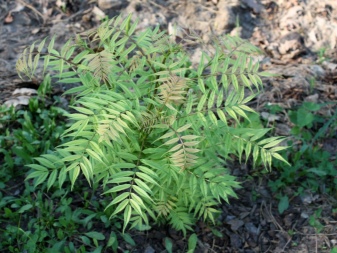
Rowan-leaved Sam
The peculiarity of this variety is in the rounded shape of the crown, as well as in a relatively low height - up to 80 cm.The leaves also have a reddish tint, however, unlike other varieties, young shoots in this plant have many small villi, which, especially after rain, create a simply charming picture in the sunlight. As in the case of ordinary fieldfare, flowers of this species are collected in pyramidal buds, however, they are slightly more common on the crown of the plant.


Rowan-leaved Stelifila
A distinctive feature of this variety of field ash is the presence of serrated beige villi on the inside of the leaves. In addition, it is one of the tallest varieties of fieldfare.In rare cases, this species can grow up to 2.5 meters. During flowering, such field ash can be represented by a huge number of snow-white buds, which form a kind of "veil". Like all varieties of fieldfare, Stelifila perfectly tolerates pruning and wintering, however, she is picky about the type of soil - she loves exclusively nutritious and fertile soils.
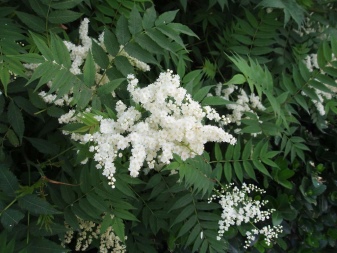
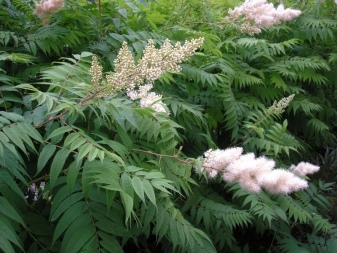
Pallas
This variety of field ash can be found only on the slopes of the Alps or in Siberia. Under natural conditions, this species can grow up to 1.3 meters. A distinctive feature is a rounded crown of the correct shape with a huge number of inflorescences. Like other species, the leaves and stems of such fieldfare are painted in a characteristic beige color. The inflorescences of this plant consist of many cream-colored buds no more than 1.5 cm in diameter. This variety can be recognized by the actively flaking bark on old shoots and stems of the plant.
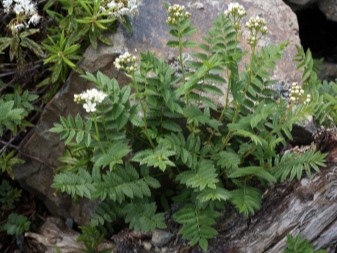
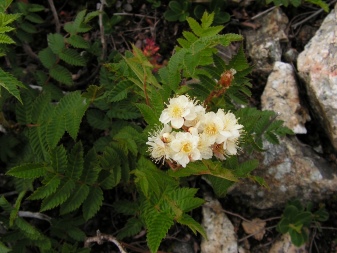
Landley
This is a fairly rare variety of field ash, which can be found exclusively in Western America. This plant differs from other varieties in its enormous height - up to 3 meters, but not particularly good health. Because of the latter, such a field ash can endure winters only under a special shelter and at a temperature of at least -20 degrees. The foliage of such a plant does not have a characteristic beige tint, the buds are rather large and white. Unfortunately, this variety of fieldfare blooms only 4 years after planting in open ground.
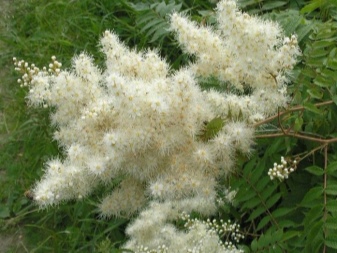
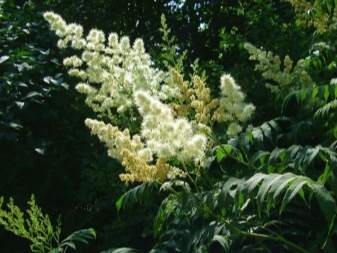
Felt
This species does not apply to garden plants - all because of the too high height of such a field ash - up to 6 meters. This plant is found in the mountains of East Asia. A characteristic feature is the complete absence of flowering and low frost resistance. If the plant is nevertheless planted on the site, then due to the ability to change the color of the foliage all year round.
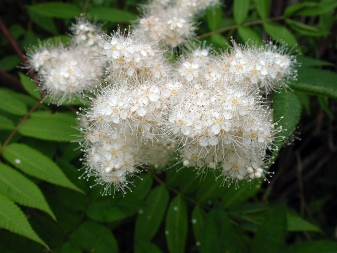

Tree-like
This is a giant among all the other varieties of fieldfare. During its life, this plant is capable of growing up to 6 meters or more in height. The flowering period of this plant is from July to August. The flowers are very large, snow-white, paniculate in shape. A distinctive feature of the variety is very slow growth. In addition to these varieties, Olga's fieldfare and Olga's fieldfare are also known, but these varieties are rare and not officially recognized.
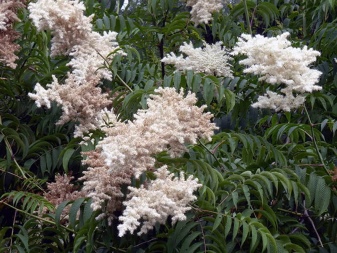
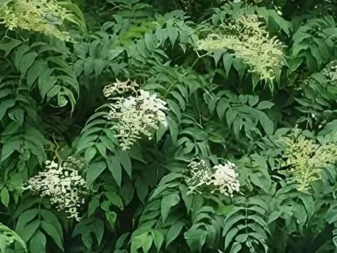
How to propagate mountain ash Sam
The propagation of mountain ash can be carried out in several ways:
- With the help of layering. The method is considered the most effective. With the onset of spring, when the soil becomes sufficiently moist, it is necessary to choose a strong, long shoot, on which there are several buds. It is sprinkled with soil, fixed in this position with a wire, leaving the upper edge of the plant on the surface. Throughout the summer, the rowan-leaved field ash cuttings are often watered, and in the fall they are cut off from the main shrub and transplanted to a pre-selected place.
- By cuttings. The method is more complicated and troublesome, but with proper implementation and care of the cuttings, it also gives a good result. It is necessary to choose a strong, healthy shoot with buds and cut it off from the top with a length of 30 cm. The cuttings are planted in a special container with a nutritious soil mixture, leaving the upper edge not covered with earth. The soil must be moist at all times. Otherwise, the shoots will not take root, the root system will not be able to develop properly, and due to a lack of moisture, the cuttings will dry out. After new leaves appear at the top of the shoots, they can be transplanted directly into the ground.
- By dividing the bush. The mother bush of the field ash variety Sam is dug up, shaken off from large clods of earth. The overhead part is cut off with a pruning shears at a height of about 5 cm. Then, with a sharp knife, they are divided into parts so that each one has 3 - 5 buds and a good lobe of roots.Too long roots are shortened, dried and sore areas are cut off. The sections are sprinkled with wood ash or fungicide powder. The separated parts must be planted immediately in the soil to prevent the roots from drying out. The seedlings are well watered and mulched with humus or high-moor peat.
- With the help of seeds. This method of reproduction of mountain ash is very rarely used, since this method is not effective enough and does not allow obtaining a positive result.
Field care in the garden
How to grow fieldberry
Planting a fieldberry and caring for it will not give you any trouble. Keep the soil around the bushes loose and slightly damp, remove weeds and undergrowth, feed the shrub if it grows in poor soil, and form the bushes with pruning if necessary.
Fieldfare is watered abundantly, especially in dry weather. The plant is fed in small portions at least twice a season, applying fertilizers superficially or embedding them shallowly. Peat, compost or humus are used as fertilizers, but sometimes mineral complexes can also be used.

Withered fieldfare inflorescences should be removed, since they significantly reduce the decorative effect of the shrub. For sanitary purposes, fieldfare is cut in early spring: damaged, dry, thickening bush or branches affected by pests and diseases are removed. If the fieldfare is not thinned out, this will lead to the formation of weak, thin and rapidly aging shoots.
The fieldberry tolerates a haircut well, including a radical rejuvenating one. Remember to regularly remove root growth.
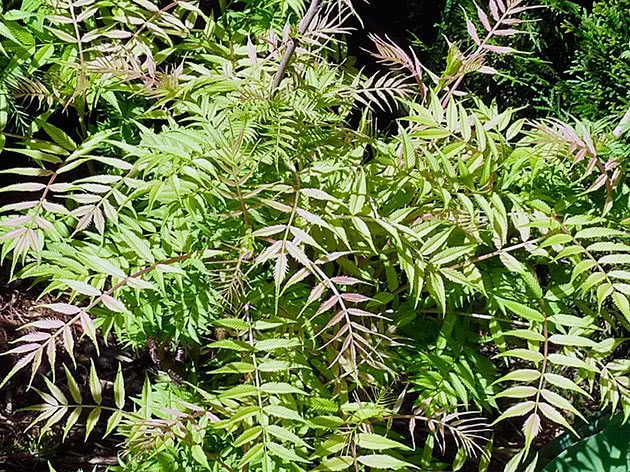
Transplanting fieldfare in the garden
A transplant will not harm the fieldfare. This procedure can be combined with dividing the bush. In spring or autumn, dig a new hole for the plant in advance, place a drain in it and prepare fertile soil by mixing the soil removed from the hole with humus or compost. Then dig up the field ash, if necessary, divide it into parts so that each of them has developed roots and strong shoots, process the cuts with crushed coal and plant the cuttings in their intended places.
If you don't need to divide the bush, just transplant it into a prepared hole, fill the space with soil mixture, compact the surface around the bush and water the plant abundantly.
Fieldfare propagation
Fieldfare is propagated by dividing the bush, which we have just described. With seed propagation of fieldfare, the probability of getting seedlings tends to zero, vegetative methods are much more reliable - propagation by layering and lignified cuttings.
Excellent results are obtained by reproduction of fieldfare by layering. In the spring, tilt a beautiful and long shoot to the ground and pin it to the ground so that several buds are in contact with the soil. Cover the shoot with earth, leaving the top on the surface. Water the cuttings all summer. The roots will appear in a few weeks, and closer to autumn, you can separate the layers from the mother bush and plant them in a permanent place.
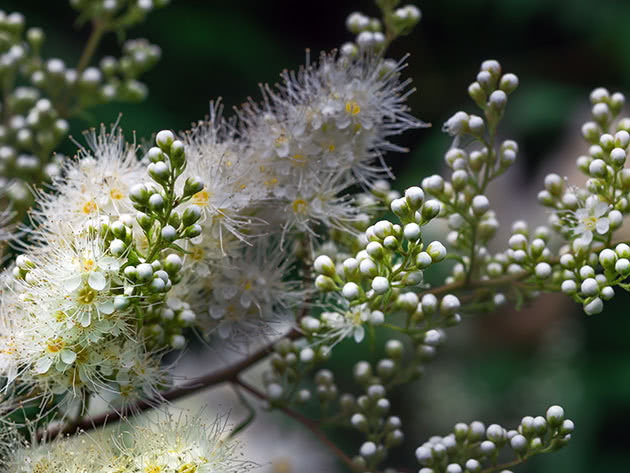
For propagation by cuttings, cut from the lignified shoots the apical segments 20-30 cm long and plant them in a box with soil mixture. Keep the substrate in a slightly damp state, and the tops of the cuttings that have started to grow will be a signal to you that the cuttings were successful.
Fieldfare pests and diseases
The fieldberry, which has high phytoncidal properties, is very resistant to diseases and pests, but sometimes it can be struck spider mite or green aphid.
Both ticks and aphids feed on the cell sap of the plant, from which it withers, its leaves turn yellow, and the shoots are deformed. In addition, sucking pests can be carriers of an incurable viral mosaic disease, and then you just have to dig up a bush and burn it. They destroy pests with a solution of Mitaka or Fitoverm preparations.



